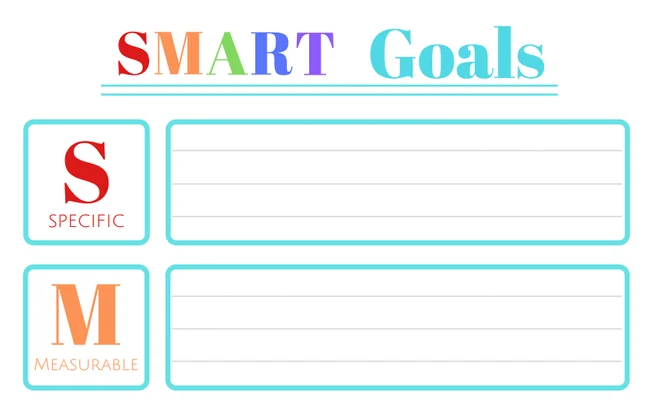SMART Goal Format: How to Set Specific and Time-bound Goals
Ever felt like you’re spinning your wheels when it comes to achieving your objectives? You’re not alone. Many of us struggle to translate our big-picture aims into actionable steps. But there’s a solution that I’ve found incredibly effective: the SMART goal format.
In the world of goal setting, SMART is a tried and tested framework that brings clarity and trackability to your ambitions. It’s an acronym that stands for Specific, Measurable, Achievable, Relevant, and Time-bound.
In the upcoming sections, I’ll unpack each element of the SMART goal format, providing you with the tools to set your goals like a pro. Get ready to turn your dreams into realities.
Understanding the SMART Goal Format

Delving deeper into the complexities of life’s goals, it’s vital that I equip myself with a navigational tool, the SMART goal format. Existing beyond a mere acronym, this format encapsulates the key elements necessary for achieving the objectives defined by life’s path.
What Does SMART Stand For?
In the realm of goal setting, SMART stands for Specific, Measurable, Achievable, Relevant, and Time-bound. Each letter representing a defining factor crucial for the effectiveness of a goal.
- Specific: Refers to goals that are clear and direct. Instead of “I want to boost my fitness level”, a more specific goal would be, “I aim to run a marathon in six months.”
- Measurable: Implies that progress can be tracked. For example, tracking the weekly running distances provides measurable data for the aforementioned marathon goal.
- Achievable: Underlines the attainability of the goal. It’s about setting up a goal that pushes limits, yet remains within reach given available resources and constraints.
- Relevant: The set goal aligns with broader life objectives. If health and fitness are top priorities, training for a marathon is a relevant goal.
- Time-bound: Finally, the goal carries a timeframe, a deadline. In the case of the marathon, the six-month timeline completes this SMART goal.
The Importance of SMART Goals
Embracing SMART goals fortifies the effectiveness of goal-setting. They eliminate ambiguity, foster focus, and provide a robust framework for tracking progress. For example, students aiming to improve their academic performance would harness the SMART principle to set multi-faceted yet tangible objectives. By stipulating that ‘I aim to attain a 4.0 GPA in the coming semester by studying for an hour each day’, students infuse their aspiration with specificity, measurability, achievability, relevance, and time constraint, leading to observable improvements over time. Undeniably, the widespread application of SMART goals can give a structured approach to realizing aspirations, a method which has been adopted by numerous individuals and organizations today.
Setting SMART Goals Effectively

Specific: Defining Clear Objectives
Clear and concise objectives form the foundation of effective goal setting. To make a goal specific, one must define what they want to achieve clearly. This practice involves answering the who, what, when, where, and why of a goal. For instance, a student aiming to improve academic performance might determine a specific goal: “I aim to increase my math grade from a B to an A by the end of the semester.”
Measurable: Tracking Progress
By introducing measurable criteria, we can monitor progress and maintain focus. Quantifiable parameters in a goal provide tangible evidence of advancement. Let’s use the aspiring athlete who wants to run faster as an example. A measurable goal might be, “I’m cutting my 5K race time by 10% in the next six months.”
Achievable: Setting Realistic Goals
Factoring in the often overlooked, yet undeniably important aspect of achievability ensures sustainability and motivation throughout the process. Tying goals to realistic expectations avoids disappointment and burnout. Remember our student from before? If they’re juggling multiple responsibilities, they could adjust the goal to say, “I’ll do two hours of math prep each weeknight to enhance my performance.”
Relevant: Aligning Goals with Objectives
Relevance amplifies the worth of a goal by aligning it with broader objectives. This alignment ensures value and avoids distraction from unnecessary tasks. Our math-aced student may extend their goal with, “I’ll improve my mathematical abilities to enhance my candidacy for an Engineering program.”
Benefits of Using the SMART Goal Format

Transitioning to the SMART goal format offers myriad benefits, underscoring its universal importance in both professional and personal contexts.
Improved Focus and Clarity
One benefit lies in how SMART goals promote both focus and clarity. Specificity, as the first component of SMART, emphasizes clear, unambiguous objectives. For instance, rather than saying, “I want to write more,” a SMART goal might be, “I aim to write 500 words per day for my novel.” This level of detail acts as a roadmap, eliminating confusion and reinforcing focus on the task at hand.
Enhanced Motivation and Accountability
Another asset of SMART goals is the sense of motivation and accountability they foster. The Measurable element of SMART allows for incremental progress tracking, which in turn fuels motivation. If we continue the previous example, tracking the daily word count helps see the progress firsthand, strengthening motivation to stay on course. In addition, SMART goals incorporate Achievable targets, keeping our aspirations realistic and hence, underscoring accountability to oneself.
Better Time Management
Furthermore, SMART goals contribute to better time management. By incorporating a Time-bound framework, goals transform from vague, open-ended tasks to time-structured responsibilities. With a set deadline, such as “I aim to complete the first draft of my novel in six months,” time management naturally becomes more efficient. Not only does it streamline the goal-attainment process, but it also fosters respect for time, optimizing productivity in the long run.
Challenges and Solutions When Utilizing SMART Goals

Navigating the process of utilizing SMART goals, while beneficial, also poses potential challenges. However, I’m here to provide solutions that mitigate these challenges, using the same Specific, Measurable, Achievable, Relevant, and Time-bound structure that defines SMART goals.
Overcoming Vague Goals
A common challenge involves setting vague objectives. Vague goals impede progress, lacking the specificity necessary for measurable outcomes. For example, a student aiming to “study better” has set a vague goal. Rectifying this necessitates clarity—establishing what “study better” means and how it’s measured.
The solution: specificity. Instead of “study better,” a SMART goal would be, “Increase study time to 2 hours per day for the next month to improve test scores.” This goal is specific, clear, and measurable, eliminating ambiguity to enhance focus and motivation.
Dealing with Unattainable Targets
Optimism, while beneficial, can sometimes lead to overambitious or unattainable targets—a harmful approach to goal setting. For instance, a salesperson aiming for a 200% increase in profits within a week has likely set an unachievable target.
The solution lies in the “Achievable” aspect of SMART goals. Modifying this goal to something more attainable, such as “Increase sales by 10% over the next quarter,” encourages greater accountability and fosters motivation by making success achievable.
Adjusting Goals to Remain Relevant
Some goals lose relevance over time—perhaps due to changes in circumstances, professional direction, or personal interests. For instance, a professional in marketing who initially aims to learn graphic design might later realize their interests lean more towards data analysis.
The “Relevant” pillar of SMART goals provides the solution. It’s crucial to reassess and adjust goals to suit evolving needs. The initial goal could adapt to, “Complete a data analysis course in the next three months,” maintaining relevance and reinforcing motivation for achievement. This approach ensures SMART goals remain effective tools in both professional and personal arenas.
Implementing SMART Goals in Different Contexts

In Personal Life
Implementing SMART Goals in personal life aids in successful navigation of life’s ups and downs. Many individuals establish goals like losing weight, learning a new skill, or saving money. However, merely expressing a desire doesn’t ensure goal realization. By converting these aspirations into SMART Goals, I affirm their specificity, determine a method for measurement, confirm their feasibility, ensure their relevance, and define a completion time. For example, if the goal is to lose weight, a SMART Goal might read: Lose 20 pounds in the next six months by incorporating 30 minutes of cardio workouts a day and controlling portion sizes.
In Business Settings
Business settings offer an ideal context for implementing SMART Goals. Be it profit maximization, improving customer satisfaction, or talent development, SMART Goals provide a solid framework for targeted efforts and measuring success. For instance, a business aiming to increase profits can set a SMART Goal: “Increase net profit by 12% in the next fiscal year by expanding high-profit product lines and reducing overhead expenses.” Here, the specifics are clear, there’s a measurement scale, it’s potentially achievable based on the organization’s performance, it’s highly relevant to the business, and it’s time-bound to the next fiscal year.
Conclusion
So there you have it: the power of the SMART goal format. It’s a dynamic tool that can transform the way you approach goal setting, both personally and professionally. By being Specific, Measurable, Achievable, Relevant, and Time-bound, your goals become clear, manageable, and ultimately, more achievable. Remember, the challenges that come with goal setting can be mitigated through the SMART framework, turning vague aspirations into targeted efforts. Whether you’re a student aiming for academic success or a business professional striving for excellence, SMART goals can be your guide. Embrace this method and you’ll find yourself navigating life’s challenges with a newfound focus and determination.
Frequently Asked Questions (Faqs)
What is the SMART goal format?
The SMART goal format refers to a method of setting goals that are Specific, Measurable, Achievable, Relevant, and Time-bound. This system emphasizes eliminating ambiguity, fostering focus, and consistently tracking progress.
How is the SMART goal format applicable to students?
The SMART goal format can be used by students to improve academic performance. By setting clearly defined, achievable goals within a given timeframe, students can significantly enhance their ability to succeed at their studies.
What are the professional and personal benefits of SMART goals?
SMART goals provide a structured framework for setting and measuring success in professional and personal contexts. They encourage focus, eradicate ambiguity and offer an objective means of tracking progress, thus leading to effective goal achievement.
What are the main challenges with using SMART goals?
The main challenges of utilizing SMART goals include dealing with vague goals, focusing on unachievable targets, and adjusting goals to remain relevant over time. By adhering to the SMART format, these challenges can be mitigated.
How can SMART goals be used in different contexts?
SMART goals can be implemented in various contexts including personal life and business settings. These goals provide a solid framework for targeted efforts, helping individuals and organizations to navigate life’s challenges and measure success effectively.

Leave a Reply